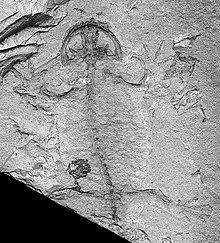
Back ضفدعيات الشكل Arabic ضفدعيات الشكل ARZ ব্যাঙরূপী প্রাণী Bengali/Bangla Batrachomorpha Spanish Batrachomorpha EU غوکریختان FA Batrachomorpha Finnish Batrachomorpha French Batrachomorpha Italian 蛙形類 Japanese
| Batrachomorpha Temporal range:
| |
|---|---|

| |
| Pangerpeton, a salamander from the Jurassic | |
| Scientific classification | |
| Domain: | Eukaryota |
| Kingdom: | Animalia |
| Phylum: | Chordata |
| Superclass: | Tetrapoda |
| Clade: | Batrachomorpha Säve-Söderbergh, 1934 |
| Groups | |
| |
The Batrachomorpha ("frog forms") are a clade containing extant and extinct amphibians that are more closely related to modern amphibians than they are to mammals and reptiles (including birds). According to many analyses they include the extinct Temnospondyli; some show that they include the Lepospondyli instead. The name traditionally indicated a more limited group.
The first tetrapods were all amphibians in the physiological sense that they laid their eggs in water, and are colloquially sometimes referred to as labyrinthodonts or stegocephalians. The term "amphibians" can be ambiguous, however. In modern phylogeny, the basalmost tetrapods are discerned from two derived branches, one consisting of the crown group of modern amphibians, the Lissamphibia, and its relatives. In this scheme, the name Batrachomorpha is given to this branch of amphibians, while the name Reptiliomorpha denotes the other branch. While the actual phylogeny of the modern amphibians is not well understood, their ancestors are descended from one line of batrachomorphs.[1] All other living tetrapods (reptiles, birds and mammals) are descended from one branch of reptiliomorphs, the amniotes. Amniotes achieved dominance, while all other reptiliomorphs and most batrachomorphs have gone extinct.
- ^ Laurin, M. (1996): Phylogeny of Stegocephalians, from the Tree of Life Web Project